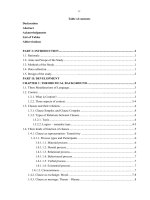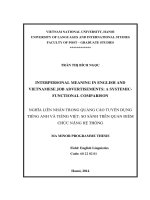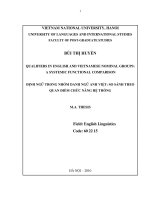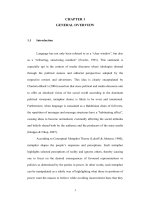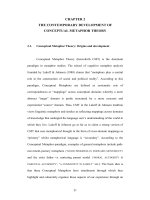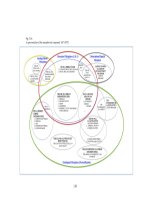Interpersonal grammatical metaphors in british and american political speeches a systemic functional approach (tt)
Bạn đang xem bản rút gọn của tài liệu. Xem và tải ngay bản đầy đủ của tài liệu tại đây (443.84 KB, 26 trang )
THE UNIVERSITY OF DANANG
UNIVERSITY OF FOREIGN LANGUAGE STUDIES
ĐOÀN THỊ DIỆU LAN
INTERPERSONAL GRAMMATICAL METAPHORS IN
BRITISH AND AMERICAN POLITICAL SPEECHES:
A SYSTEMIC FUNCTIONAL APPROACH
Major : ENGLISH LINGUISTICS
Code :
822.02.01
MASTER THESIS IN
LINGUISTICS AND CULTURAL STUDIES OF
FOREIGN COUNTRIES
(A SUMMARY)
Da Nang, 2019
This study has been completed at University of Foreign Languages
Studies, the University of Da Nang
Supervisor: Assoc. Prof. Dr. TRAN HUU PHUC
Examiner 1: Trần Bá Tiến, Ph.D.
Examiner 2: Assoc. Prof. Dr. lưu Quý Khương
The thesis was orally defended at the Examining Committee
Time: 06th January 2020
Venue: University of Foreign Language Studies – The
University of Da Nang
This thesis is available for the purpose of reference at:
- Library of University of Foreign Language Studies, The
University of Da Nang.
- The Center for Learning Information Resources and
Communication – The University of Da Nang.
1
CHAPTER 1
INTRODUCTION
1.1. RATIONALE
It is obvious that language plays an important role in various
aspects of our daily lives as a mean of communication. Therefore, to
communicate effectively, language users have been using many
figures of speech such as: simile, personification, allusion, diction to
help the recipients understand the emotion of the speaker and
imagery of the idea being conveyed. And one of the most well –
known stylistic devices which is commonly used to convey messages
from the senders, strongly affects on the listeners or the readers'
understanding the messages is metaphor. Metaphor is used in
literature, in art, in advertisement, in everyday speeches, in formal
language, etc. and by all people who use language: children, adults,
workers, farmers, businessmen, journalists, politicians, etc. Among
them, politicians are the people whose speeches attract the largest
number of people’s attention. Language is one of the most effective
and powerful weapons used by politicians and they are all aware of
the importance of language to what they want to show people. They
use language to persuade their listeners, to stir their emotions, to give
them a sense of occasion, to make their audience thinking about what
they say and to make them agree with their views.
For example, to make his audience believe and agree with him
that Senator McCain really cares of American people’s life. Instead
of saying that “Senator McCain really cares what is going on in the
lives of Americans”, The President of The United States- Barack
Obama says: -“I don’t believe that Senator McCain doesn’t care what
is going on in the lives of Americans”. When adding the projecting
2
mental clause (see 2.2.3.4.b) “I don’t believe”, Obama wants to send
a message that he strongly believes that McCain really cares of
Americans. The clause also gives the Finite in main clause its
negative form. Hence “I don’t believe….doesn’t care” can helps
speaker persuade and make audiences believe that McCain really
cares of their lives.
Next, language helps politicians to interact with other people,
to establish and maintain relations with them. For instance, when
asking someone to do something, people usually use the imperative
mood. However, when The UK Prime Minister David Cameron asks
British people to work to show the world that Britain is an open
country for business. He hasn’t said “get down to work, to make sure
we send out a big signal: this country is open for business” buts said:
“I want you all to get down to work, to make sure we send out a big
signal: this country is open for business”. The clause “I want you”
functions as an imperative mood but it makes the command softer
and more polite. So it’s easily accepted and carried out by the
hearers.
Moreover, language also reveals the social status and power
relationship between politicians and listeners. When Cameron uses
the clause “I want you”, the verb “want” sends the audience a
message that this is a command. You all have to obey this. I am a
president and you should do what I ask you to do.
Because of the above reasons, the interpersonal function of
language is always concerned in PSs and PSs are always prepared
very well before giving out to the public. To make their speeches
more convincing and interesting, the use of grammatical metaphor
(GM) in political speeches occur not less frequently than in other
discourses. Moreover, due to their great importance, PSs are the most
3
favorite data source of linguistic researches. As a result, there have
been many studies on the use of GM in PSs in recent decades.
However, there has been no study on IGMs in British and American
political speeches.
In order to explore how British and American politicians use
IGMs in their PBs, and what effects these usages can bring about for
the intention of the speakers, what effects they cause to listeners, and
the difference in the use of IGMs between British and American
politicians, I decide to conduct a study on the topic: “Interpersonal
grammatical metaphors in British and American political speeches: a
systemic functional approach”. I hope that the research will help
readers be able to comprehend the employment of IGMs as well as
exploring the difference in the ways IGMs are applied between
British and American people.
1.2. AIMS AND OBJECTIVES
1.2.1. Aims
The research aims at investigating the use of IGMs by Bps and
Aps in terms of their semantic and pragmatic features as well as
popularity, frequency from a systemic functional perspective. Also,
the study attempts to discover the differences in the use of IGMs
between British people and American people.
Hopefully, the research’s results support English learners in better
understanding of theoretical and practical using of IGMs and help
them apply in understanding and using English more easily.
1.2.2. Objectives
With the above-stated aims, the following objectives are set:
- Examine some semantic and pragmatic features of IGMs
used in PSs by British and American politicians.
4
-
Point out the similarities and differences in the semantic role
and the pragmatic features of IGMs in British and American
politicians’ speeches.
- Help English learners use IGMs more easily and effectively.
1.3. SCOPE OF THE STUDY
I intend to confine this study to the semantic and pragmatic
features of IGMs on the theories of SFG of Michael Halliday and
present a comparison of the use of IGMs in British English and
American English through the analysis of data collection from 112
British and American PSs which are divided into two corpora named
APS and BPS.
1.4. RESEARCH QUESTIONS
In order to achieve the aims and objectives mentioned above,
this study should give answers to the following research questions:
1. What types of IGMs are deployed in political speeches by
British and American politicians?
2. What are semantic and pragmatic features of IGMs employed
in PSs by British and American politicians?
3. What are the similarities and the differences in the use of
IGMs of British and American politicians?
1.5. SIGNIFICANCE OF THE STUDY
With the analysis on the semantic, pragmatic features of IGMs
in British English and American English, I hope that:
- The research would help Vietnamese learners have a
comprehensive understanding of the use of IGMs in spoken English,
especially, help language users have a better insight into the
linguistic features at the systemic functional level.
5
- Additionally, the findings are supposed to be a useful source
which can be applied for anyone who are interested in practical
application in reading and writing political speeches in particular.
1.6. ORGANIZATION OF THE STUDY
The study is organized into five chapters as follows:
Chapter 1. Introduction
This chapter consists of an introduction to the thesis in terms of
rationale, aims and objectives, research questions, scope of the study,
significance of the study and organization of the study.
Chapter 2. Literature Review and Theoretical Background
This chapter presents a brief review of previous studies related
to the present research. It also provides the theoretical background on
which the research is based.
Chapter 3. Methods and Procedures
This chapter describes research methods, description of samples,
tools used for data collection, data analysis.
Chapter 4. Findings and Discussions
This chapter analyzes semantic and pragmatic features of IGMs
in British and American PSs. The similarities and differences in the
use of these in PSs are identified and analyzed.
Chapter 5. Conclusions and Implications
This chapter summarizes the results of the study and provides
some implications for using IGMs. Furthermore, the statement of
limitations and some suggestions for further research are also
presented.
6
CHAPTER 2
LITERATURE REVIEW AND THEORETICAL
BACKGROUND
2.1. REVIEW OF PREVIOUS STUDIES
Halliday (1985; 1994; 2004; 2014) in “An Introduction to
Functional Grammar” claims that GM involved in ideational
grammatical metaphor which concerns the variations in expressing
ideas and interpersonal grammatical metaphor which concerns the
interpersonal relations.
Based on Halliday’s framework of GM from the perspective
of SFG there have been a lot of research works carried out on the
both main types of GM. In relation to studies on IGMs, there have
been some research studies carried out so far.
Suzuanne
Eggins
(2000)
provided
a
thorough-going
overview of how clause is structured to help people expressed kinds
of interpersonal meanings. Miriam Taverniers (2008) concerned with
central types of interpersonal expressions, focused on the nature of
IGMs, compared the concept to the other related phenomena and
defined IGMs as a construction type based on a doubling of semiosis:
a doubling of scoping in structural terms, and a doubling of
grounding in semantic terms. Yang (2013) tried to explore the use of
IGMs in spoken Chinese. Thomas Bloor and Meriel Bloor (1995)
present a short account to the way to analysis English for anyone
wants to start out with SFG. Eggins (1994) introduces the principles
and techniques of the functional approach to language in order to
help readers begin their own researches in analyzing how meanings
are made and how language is organized in authentic everyday
interactions .
7
Regarding to British and American political speeches, Trần
Hữu Phúc (2017) used a corpus- based analysis to examine the link
between the employment of modality expressions and politeness
strategies in British and American ambassadorial speeches. In his
research he investigated the frequencies of modality markers and
compared the frequencies of modal forms occurring in two corpora of
British and American ambassadors’ speeches. Although there are
many research studies carried out on GM and IGMs, to my
knowledge there has been no studies done on IGMs in American and
British political speeches in the perspectives of SFG. Hence, I hope
that my thesis will contribute a minor part to fulfill the overall picture
of this field.
2.2. THEORETICAL BACKGROUND
2.2.1. Systemic Functional Grammar
2.2.2. Grammatical metaphor
2.2.3. Types of GM under the SFG Perspectives
2.2.4. Types of interpersonal grammatical metaphors
2.2.5. Political speeches
8
CHAPTER 3
RESEARCH METHODOLOGY
3.1. METHODOLOGY
On the purpose of making an investigation into linguistic features
of IGMs of PSs, a corpus-based method - the combination of both
qualitative and quantitative method of collecting and analyzing datais used to reach the aims of the study.
A corpus linguistics (“corpora” in plural) is a collection of texts
used for linguistic analyses and usually stored in an electronic
database so that the data can be accessed easily by means of a
computer. Corpus texts usually consist of thousands or millions of
words and are not made up of the linguist’s or a native speaker’s
invented examples but on authentic spoken and written language.
Tran, H. P. (2014), describes corpus-based methodology “relies
on research corpora and reference corpora as authentic sources of
data for analysis. The former is compiled to explore a particular
genre and the latter is used to explore the language in general and to
provide data for comparison with results collected from the former.
Corpus-based research can essentially be seen as a way of studying
real-life language via a computerised collection of texts.”
From the description, it is obvious that the corpus-based method
has four main following characteristics: working with authentic and
natural texts; using a large and intended collection of real-life texts to
analyze; using computer, both automatic and interactive techniques
for analysis; using both qualitative and quantitative method for
analysis. (Tran, H. P. (2014))
This method can be seen as an objective, effective and accurate
way to examine and analyze data. As a result, there have been more
and more researches carried out using corpus-based method and
9
make it become the mainstream, a tool to revolutionize the study of
language and of the applications of language.
This study aims to research on the IGMs in American and British
political speeches, so it is quite necessary to employ the corpus-based
method to reach the result exactly and effectively.
3.2. SAMPLING
3.2.1. Building the corpora
To reach the aims of the study and to satisfy the principal issues in
designing research corpora, I have to collect 112 speeches delivered
by American and British politicians from 1975 to 2011 from the
internet and newspapers then classify them into two groups:
American political speeches (APS) and British political speeches
(BPS) to build two research corpora as presented in table 3.1.
Table 3.1. The corpora used in the study
Corpora
Speakers
Date range
Number of
speeches
Number of
words
APS
A 01- A 04
1981-2004
58
191,316
BPS
B 01- B 04
1975-2007
44
197,479
Also, it is needed to analyze the two corpora to have the quantity
of IGMs instances to provide data for the quantitative analysis. In
order to have an automatic search with an exact, effective and
objective result, I used the software Wordsmith 5.0, an integrated
suite of programs for looking at how words behave in texts, for help.
3.2.2. Using the software Wordsmith 5.0
The software Wordsmith 5.0, the software for finding patterns in
text, has three main tools with three fundamental functions: “The
WordList tool lets you see a list of all the words or word-clusters in a
text, set out in alphabetical or frequency order. The concordancer,
Concord, gives you a chance to see any word or phrase in context -
10
so that you can see what sort of company it keeps. With KeyWords
you can find the key words in a text.” ( Mike Scott, 2010)
Figure 3.1. The main functions of Wordsmith 5.0 tool
With the above advantages, the Wordsmith 5.0 is used to search
and have concordance lines of each type of the IGMs expressions in
the corpora, to know the distributions of IGMs instances in all
speeches, to visualize the source text in which IGMs expressions are
located and then, to provide statistical data for a quantitative analysis.
The result from the analysis is applied for the next analysis method:
qualitative analysis method.
3.3. DATA COLLECTION
The data used in the study are collected from official speeches
by four American Presidents and four British Prime Ministers. The
process of collecting data is followed the steps below.
- Firstly, search engine Google is used to collect 112 speeches of
the four presidents and the four prime ministers from online
newspapers and video.
- Next, the collected speeches are manually coded to list out all
the expressions of the two types IGMs of mood and IGMs of
modality. In fact, I myself have to read all the collected speeches to
identify the IGMs expressions used in the speeches.
- Then, the software Wordsmith 5.0 is used to search for and
measure the numbers of each subcategory of IGMs of mood and of
modality in the corpora, to know how the IGMs occur in the speeches
and to have data for the quantitative analysis.
11
- Finally, the statistical data collected from the quantitative
analysis above is deployed and analyzed to compare the use of IGMs
in APS and BPS.
In Table 3.2, the APS consists of 58 speeches delivered by the
four American Presidents: Bush Junior (US01 in the period from
2001to 2004), Bill Clinton (US02 in the period from 1993 to 1998),
Barack Obama (US03 in the period from 2005 to 2009) and Ronald
Reagan (US04 in the period from 1981 to 1992) in the size of
191,316 words. Likewise, the BPS consists of 44 speeches delivered
by the four UK Prime Ministers: Tony Blair (UK01 in the period
from 1999 to 2007), Gordon Brown (UK02 in the years from 2007 to
2010), David Cameron( UK03 in the two years 2010 and 2011) and
Margaret Thatcher ( UK04 in the period from 1975 to 1989) in the
size of 197,479 words.
3.4. DATA ANALYSIS
The analysis of the data is carried out in the following process to
produce both quantitative and qualitative information for the research
of IGM.
- The samples in APS and BPS are examined and coded manually
to identify the IGMS expressions by reading all the collected
speeches in the two corpora.
- The IGMS expressions then categorized into two groups:
metaphor of mood (MMd) expressions and metaphor of modality
(MMy) expressions according to the linguistics features of the two
types of IGMs (as I have presented in Section 2.2.5) to use for an
automatic search.
- The software Wordsmith 5.0 is used to identify the IGMs
instances and provide statistical information of each subcategory of
IGMs in each corpus.
12
- The statistical data collected from the automatic analysis is used
for the quantitative analysis to define the distribution of each element
of IGMs in APS and BPS.
- The result from the quantitative analysis is used for the
qualitative analysis in choosing suitable utterances from the two
corpora to analyze and compare the use of IGMs between American
politicians (Aps) and British politicians (BPs) in their speeches to
find out the semantic and pragmatic aspects of IGMs in PSs.
3.5. RELIABILITY AND VALIDITY
This study with the use of a corpus linguistics method is
guaranteed in the reliability and validity because:
- Firstly, the data source is collected from American and British
politicians’ speeches so it is quite native and real- life language .
- Next, the corpus based method with its principle and its
advantages gives us objective and authentic results.
- Also, the IGMs expressions collected from the corpora are used
in many different real-life context and in different situations.
- In addition, corpus method is a computerized tool, so the result
given from it is not only in a very short time but automatic and
accurate.
In summary, I am sure that the data, the method and the result of
this thesis is believable and assured.
3.6. SUMMARY
Chapter 3 describes research methodology of the thesis and the
steps the samples were collected. Additionally, the procedures for
data analysis and reliability and validity are also presented in this
chapter as that the foundation for detailed findings and discussion in
Chapter 4 can be carried out.
13
CHAPTER 4
FINDINGS AND DISCUSSION
4.1.
TYPES
OF
INTERPERSONAL
GRAMMATICAL
METAPHORS EMPLOYED IN POLITICAL SPEECHES BY
AMERICAN AND BRITISH POLITICIANS
4.1.1. Metaphor of modality
4.1.1.1. Metaphorical realizations of probability (MRoP)
a. MRoP high value with subjective explicit
b. MRoP median value with subjective explicit
c. MRoP low value with subjective explicit
d. MRoP high value with objective explicit
e. MRoP median value with objective explicit
f. MRoP low value with objective explicit
In sum, there are six types of MRoP employed in the political
speeches used in research data.
4.1.1.2. Metaphorical realizations of usuality (MRoU)
a. MRoU high value
There is no data of MRoU high value found in the research
corpora.
b. MRoU median value
c. MRoU low value
There are only four instances of metaphorical realizations of
low value usuality, four instances of median value and no instances
of high value are found in the research data.
4.1.1.3. Metaphor of obligation
a. MRoOb high value with subjective explicit
b. MRoOb median value with subjective explicit
c. MRoOb low value with subjective explicit
14
d. MRoOb high value with objective explicit
e. MRoOb median value with objective explicit
f. MRoOb low value with objective explicit
Among six types of MRoOb there are three types: MRoOb
high value using subjective explicit, MRoOb median value using
subjective explicit and MRoOb high value using objective explicit
found in the corpora.
4.1.1.4. Metaphorical realizations of inclination(MRoI)
a. MRoI high value
b. MRoI median value
c. MRoI low value
Among the three types of MRoI, the MRoI high value has the
highest occurrence. MRoI median value comes second in the row and
MRoI low value is the least.
4.1.2. Types of metaphor of mood employed in political
speeches by American and British politicians
4.1.2.1. Metaphorical realizations of Command (MRoC)
a. MRoC expressed by modulated interrogative mood
b. MRoC expressed by declarative mood
There are only 35 occurrences of command expressed by
modulated interrogative mood in both APS and BPS (11 and 24
respectively), there are up to 1088 instances of command expressed
by declarative mood found in the research data. The statistic data
reveals the fact that Aps tend to prefer giving command to hearer(s)
than Bps.
4.1.2.2. Metaphorical realizations of Statement(MRoS)
a. MRoS expressed by interrogative mood
b. MRoS expressed by tagged declarative mood
It can be noted that both Aps and Bps tend not to use many
15
MRoS expressed by interrogative and tagged declarative to express
the senses of statement.
4.1.2.3. Metaphorical realizations of Question(MRoQ)
a. MRoQ expressed by modulated declarative
There are only six occurrences found in the corpora.
4.1.2.4. Metaphorical realizations of Offer ( MRoOf)
a. MRoOf expressed by declarative mood
b. MRoOf expressed by imperative mood
MRoOf is the largest type of IGMs employed by Aps and
Bps in PSs used in the research. Among the 1389 instances, 976
occurrences belong to the MRoOf expressed by declarative mood,
nearly twice as many as MRoOf expressed by imperative mood
which has 413 instances.
4.2. SEMANTIC FEATURES OF IGM USED IN AMERICAN
AND BRITISH POLITICAL SPEECHES
4.2.1. Judgement and confidence
4.2.1.1. Certain judgement
In PSs collected in the research corpuses, speakers use MRoP
high value to express their certain judgments about the events
mentioned in utterances. The projecting clauses used in MRoP are
identified as giving speaker’s certain judgments of an event/ a
problem or a country’s future. It is interesting that, both Aps and Bps
use a lot of MRoPs with subjects I and we.It can be explained that the
politicians are very confident of the possibility of the events and
actions presented in the utterances. Moreover, they tend to prefer to
express
their
confidence
to
communicative purposes.
4.2.1.2. Neutral judgement
hearer(s)
with
very
specific
16
In PSs, neutral judgement is realized by the MRoP subjective
explicit with median value. This type of metaphor reveals that there
is an unsure of the truth and the possibility of the events uttered in the
speakers’ utterance. The frequencies of MRoP median value are
almost equal with 89 instances found in APS and 97 found in BPS.
4.2.1.3. Objective judgment
To express judgements objectively, politicians use the MRoP
objective explicit with impersonal subjects. From the frequencies of
subjective judgement found in the research data, it can be argued that
both American politicians and British politicians are too confident to
express their judgement objectively.
4.2.2. Command and social power
4.2.2.1. Strong command
With more than one thousand instances expressing strong
command, it cannot be denied that both Aps and Bps give many
strong commands using declarative mood in their PSs. Surprisingly,
the data collected from APS and BPS shows that, American
politicians use almost double command expressed by IGMs than
British politicians do, accounting for 692 instances and 396 instances
respectively. The statistic data shows that Aps tend to be more
determined and powerful than Bps.
4.2.2.2. Neutral command
The neutral command used in both APS and BPS is much
less than the strong command with 323 instances in comparison to
800 respectively. The statistic data reveals that politicians tend to
assert their social power, social distance to the hearers through strong
command by using metaphor of mood. Neutral command is used to
make the hearers feel comfortable and have a sense of a close
17
relationship. Hence, to achieve their communicative purposes
different types of command will be employed in political speeches.
4.2.3. Commitment, willingness and responsibility
4.2.3.1. Strong commitment
There are 976 instances expressing strong commitment found
in the two corpuses APS and BPS. The data shows that both Aps and
Bps give a lot of strong commitments to their hearers using MRoO
expressed by declarative mood. As observed in the two research
corpora, MRoO expressed by declarative mood occurs with the
higher frequencies in APS with 548 instances out of 976 instances
found, and the left 428 instances belongs to BPS.
4.2.3.2. Strong willingness
The data collected in the research corpora show that Bps
employ more strong willingness expressions than Aps do. This can
be explained that BPs appear to be more confident and willing to
express their personal enthusiasm for doing things for people and
country. The statistic shows that both Aps and Bps prefer to use an
inclusive pronoun to express their willingness. The pattern are used
to emphasize the speakers’ persuasion of desiring the hearers’ cooperation with them in performing the event mentioned in their
utterances. Moreover, the use of pattern let us in political speeches
gives hearers the feeling of wanting to contribute to and share the
responsibility to build a better country, to have a brighter future.
4.3. PRAGMATIC FEATURES OF IGM USED IN AMERICAN
AND BRITISH POLITICAL SPEECHES
4.3.1. MRoP expressing confidence
The high frequency of MRoP employed in political speeches in
this research show that the politicians are always confident in
18
themselves, in their ability to make what they wish come true, in their
leader skills. Moreover, they want to convey the faith to hearers to
give them the belief in a good and successful future.
4.3.2. MRoOf expressing responsibility
With the use of MRoOf and MRoI, speaker is attempting to persuade
hearer and to show their high responsibility, their ability to take
responsibility for leading a country.
4.3.3. MRoMd expressing social power
Employing MRoC by declarative mood can help speaker express
their power, the social distance to hearer.
4.3.4. IGMs expressing the solidarity
A lot of IGMs using inclusive pattern we, it is used to express the
solidarity. The subjects give the sense of cooperation between
speaker and hearer(s). Moreover, it gives hearer(s) the sense of
belonging to the same social group with speaker. It shortens the
social distance and creates the cooperative and friendly atmosphere
between speaker and hearer(s).
4.3.5. IGMs saving hearers’ face
Different types of IGMs are used to reduce the impositions from
the speaker to hearers and minimize the threat to the hearers’ face. .
By sharing their care, respect and solidarity, speaker express the hope
to shorten the social distance between them and the hearers; hence,
create a closer relationship and atmosphere.
4.4. THE SIMILARITIES AND DIFFERENCES IN THE USE
OF IMGS OF AMERICAN AND BRITISH POLITICIANS
4.4.1. The similarities in the use of IGMs in American and
British political speeches.
19
4.4.2. The differences in the use of IGMs in American and
British political speeches
4.4.2.1. The differences in using IGMs to express
probability
Comparison of the frequency use of MRoP in APS and BPS
shows that British politicians use more MRoP to express the
judgements about the likelihood of event or action presented in
utterance than American politicians. The higher frequencies
employed in BPS indicates that British politicians are quite more
confident of judging events or actions than American politicians.
They tend to express their personal confidence and judgements on the
possibility for the performance of the event presented more easily
than their peers in America.
4.4.2.2. The differences in using IGMs to express obligation
The frequencies of other types of MRoOb found in APS are
much higher than in BPS. Therefore, it can be concluded that Aps
prefer to impose strong obligation on hearer(s) directly and
powerfully than Bps.
4.4.2.3. The differences in using IGMs to express command
In sum, with the social position of a country’s leader, both
American president and British prime minister prefer to give a lot of
commands to hearer(s). But the frequencies of MRoC found in the
research corpora shows that American politicians are stronger and
more determined than British politicians in giving commands
20
CHAPTER 5.
CONCLUSIONS AND IMPLICATIONS
5.1. CONCLUSIONS
After analyzing 112 speeches collected from four American
presidents and four British prime ministers, there are a wide range of
categories of IGMs found in PSs ranging from MRoP, MRoU,
MRoOb, MRoI, MoC, MoOf, MoQ, MoS. Although there are some
types of IGMs which are not found in PSs in the research corpora
such as MRoU high value, MRoOb low value with subjective
explicit, MRoOb median value with objective explicit, MRoOb low
value with objective explicit and MRoQ expressed by imperative, the
other types such as MRoP high value with subjective explicit, MRoP
median value with subjective explicit, MRoOb high value with
subjective explicit, MRoI high value, MRoC expressed by declarative
mood are employed with very high frequencies by both APS and
BPS. And the other types such as MRoU median value, MRoU low
value, MRoP low value with subjective explicit, MRoP high value
with objective explicit, MRoP median value with objective explicit,
MRoP low value with objective explicit, MRoI median value,MRoI
low value, MoC expressed by modulated interrogative, both types of
MoS, MoQ expressed by declarative all appear in a very low
frequencies in both research corpora.
Semantically, IGMs carry a wide range of meanings implied by
both American and British politicians in their PSs. This thesis
focuses on three main aspects of the semantic features of IGMs in
political speeches. The first is judgement and confidence. The finding
shows that politicians use all the six types of MRoP to express their
judgements about the performance of event presented in the
21
utterance. Through the use of different projecting clauses in each type
of MRoP, the speaker expresses confidence to what he/she is
presenting. In this aspect, British politicians tent to be more
confidence than American politicians when they use a lot of instances
of MRoP, especially MRoP subjective explicit high value to express
their judgements. The second semantic aspect is command and social
power. To express command, both Aps and Bps employ a
considerable number of commands expressed by declarative mood.
The variety expressions used to express commands in declarative
mood reveals the social power and social distance of speaker to
hearer. In this aspect, American politicians tent to be more powerful
and stronger when they use a lot of MRoC to give command to
hearer(s). The last one regarding to commitment, willingness and
responsibility. Both American and British express many strong
commitments to hearers by using the MRoOf expressed by the
declarative mood. The politicians employ many MRoOf expressed by
imperative mood to convey their willingness to do their best for their
country, for people and the world. With the same goal to persuade
hearer(s), in the aspects of commitment and willingness, there is not
much difference between Aps and Bps when the frequencies
employed in both corpuses are nearly the same.
Regarding to pragmatic features, in PSs, IGMs are used to build
and maintain a friendly relationship between speakers and hearers
when speakers use MRoP to express their confidence, use MRoOf to
convey their responsibility. To express command, instead of using
imperative mood which could lose hearers’ faces, politicians use the
MRoC expressed by declarative and interrogative mood to soften the
commands, save the hearers’ faces and reduce the social distance
22
between them but still show hearer(s) their higher social power.
Hence, MRoC is used to express both social power and the solidarity
from speakers to hearer(s). Furthermore, plural personal subject we
and impersonal subject it/there/etc. are also used to maintain a close,
friendly atmosphere between speakers and hearers.
In conclusion, although there are many similarities in types,
semantic and pragmatic features of IGMs used in both American and
British political speeches, the difference in the frequency of some
types of IGMs employed in each research corpus shows us the
differences in the use of IGMs of American politicians and British
politicians. The statistic found in the research shows that American
politicians are more interested in using types of IMGs subjective
explicit high value with first personal pronoun I than British
politicians. This means that American politicians prefer to express
events and actions presented in their utterances more powerfully and
determinedly when giving political speeches than British politicians.
5.2. IMPLICATIONS
The study can have the following implications:
Firstly, the exploration of types of IMGs used in political
speeches has made a small contribution to identifying and
understanding of the use of IGMs in spoken English.
Secondly, the findings of semantic and pragmatic features of
IGMs used in the data in this thesis are expected to help language
users have a better insight into the linguistic features of IGMs when
using in PSs by native English speakers at the SFG level.
Thirdly, the findings of the similarities and differences between
the use of IGMs of American and British speakers hope to help
23
language learner have a better understanding of the use of IGMs in
American English and British English.
Finally, this thesis is supposed to be source of useful knowledge
which can supply anyone who has interest in practical application in
using IGMs in reading and writing political speeches.
5.3. LIMITATIONS OF THE STUDY
Because of the limit of time and knowledge of the researcher, this
study has a number of limitations despite the fact that the researcher
has tried best. The first problem is as Halliday and his followers have
claimed that IGMs is not a linguistic device that can be identified
clearly and easily; hence, mistakes may be made during the research.
Next, only the speeches of four American Presidents and four British
Prime Ministers from the year 1975 to 2011 employed in analyzing.
Thus, speeches from other periods of time are not included in this
study, and this may cause some limitations in the use of IGMs in
modern English. Moreover, the size of the corpora is not large
enough to cover all the cases of IGMs used in political speeches. In
addition, the study concerns the comparison between the language
features of IGMs in speeches by American and British politicians
only; therefore, it seems that the research cannot demonstrate
throughout the distinctive features of English in general.
5.4. SUGGESTIONS FOR FURTHER RESEARCH
This current study is restricted in exploring only IGMs under the
umbrella of the SFG. Moreover, due to the limitation of time and
ability, the thesis is only limited to the study on the types, semantic
and pragmatic features of IGMs. PSs with their very unique features
are interesting linguistic source to carry out many other linguistic

